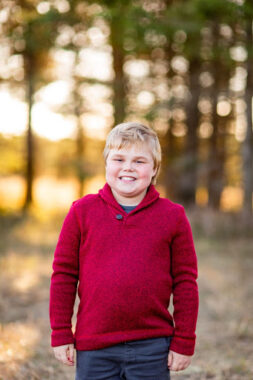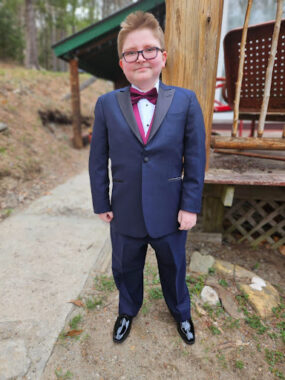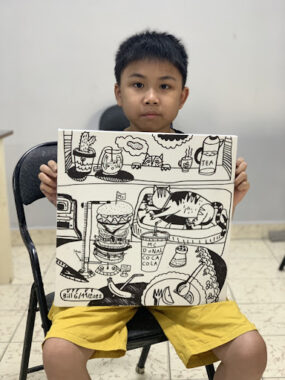A journey of hope, love, and perseverance: Raising a child with Duchenne muscular dystrophy
For parents and caregivers, a new diagnosis of Duchenne muscular dystrophy (DMD) can feel overwhelming. There’s no road map to managing the physical and mental changes in your child’s health, overcoming daily challenges, dealing with your child’s questions, confronting frustrations, and ultimately, helping them maintain their quality of life.
However a variety of strategies and tactics can help both parents and children affected by DMD navigate this new world. From managing early symptoms, to maintaining mobility, to finding support and resources, the steps you take today can help your child live a full life.
Early DMD symptoms and disease progression
DMD is a progressive muscle-wasting condition that mainly affects skeletal and heart muscles. It is one of many types of muscular dystrophy, an inheritable condition marked by progressive muscle weakness. The disease is much more common in boys than girls. Symptoms typically first appear around age 2 or 3 and become progressively worse with age.
Barry Byrne, MD, the associate chair of pediatrics and director of the Powell Gene Therapy Center at the University of Florida and chief medical adviser of the Muscular Dystrophy Association (MDA), says delays in learning to walk are one of the first signs of DMD in a toddler.
“Most children should be walking independently by 18 months. Delays beyond 24 months should be further evaluated,” he says. “In addition, signs of weakness may be evident with clumsiness and frequent falls.”
As the child gets older and starts walking, Byrne says boys may have difficulty climbing stairs, especially without a handrail, and sometimes have a unique walking pattern known as “toe walking.” The calf muscles may also become enlarged, and falls become more common.
“Boys with DMD have motor developmental delay that becomes progressively worse until the fifth birthday when there is no further developmental progress and a loss of skills begins,” Byrne says. “By age 10, boys will lose ambulatory function and no longer walk independently.”
As time goes on, the extreme and progressive muscle weakness makes walking difficult, and most patients will need a wheelchair to move around by the time they are in their teenage years.
While there is not yet a cure for DMD, a number of treatments exist to ease symptoms and slow or halt disease progression — including exon-skipping therapies and gene therapy — which may keep patients walking for longer.
Educating yourself about DMD
Generally, mutations in the DMD gene, the genetic cause of DMD, are passed from parents to their biological children. But in about one-third of cases, mutations arise spontaneously, and DMD children are born to parents that do not carry the mutated gene.

Ben Schwartz (Photo courtesy of Jen Schwartz)
This is the case for Jen Schwartz’s 10-year-old son, Ben; neither she nor Ben’s father carry the mutation. Jen serves as the Connect coordinator for Parent Project Muscular Dystrophy’s (PPMD) Iowa Connect group.
“It really surprised us when he was diagnosed at the age of 3,” she says, adding that their family has learned a lot about the disease in the past seven years. “Neither my husband nor I have any medical background. But we dove in and learned awfully quickly and have started to learn a lot about genetics and all of the things that come with muscular dystrophy.”
Schwartz was excited about the June 2023 announcement that the U.S. Food and Drug Administration granted approval to Elevidys (delandistrogene moxeparvovec-rokl), a gene therapy for treating kids, ages 4 to 5, who have Duchenne muscular dystrophy and are able to walk.
“I think that’s really the first wave of these therapies for Duchenne muscular dystrophy,” she says.
To learn more about DMD, she recommends parents join PPMD, which focuses on research to speed up the development of new treatments for DMD, advocates on behalf of patients and their families to all levels of government, works to improve access to optimal care for all patients, and connects the DMD community to one another and to the latest news about DMD.
At first, Phuong Luu, who lives with her 12-year-old son, Danh Nguyen, in Ho Chi Minh City in Vietnam, had only the internet as a source of information about DMD.
“Since then, we, the Duchenne Vietnam community, have joined the World Duchenne Organization (WDO) as an aspiring member. Now we have opportunities to reach truth-worthy, up-to-date information about the disease as well as care guides,” Phuong says.
Phuong says the WDO helps her son receive the best care because she is knowledgeable about the latest standards of care for Duchenne and can discuss it with her son’s neuromuscular clinician.
“Doctors give different regimens depending on their speciality and their own experience,” Phuong says. “I hope that hospitals will apply for the Accredited Duchenne Care Center program led by WDO in the future so people with Duchenne in Vietnam can access suitable care to improve their quality of life.”
In addition to speaking with your child’s healthcare provider, there are other resources such as the news, columns, and community forums on Muscular Dystrophy News Today that help parents navigate the complex condition.
The MDA also has resources and a nationwide network of 150 Care Centers with access to the expertise of MDA physicians and support staff.
Talking to your child
A common subject among parents of children with DMD is age-appropriate language and how to decide, as their children get older, how much to tell them and when.
“The conversation has evolved over time from when Ben was 3 years old to 10 years old. So we talk about how his muscles are generally weaker than his friends,” Schwartz says. “We can still usually do the same things he’s interested in; we just have to figure out a different way to do it.”
Ben attended a camp with other children with various types of muscular diseases and different levels of ability. This started him thinking about the progression of his own situation.
“It was a little hard on him to see what happens,” she says. “But I think it’s also helpful for him to see and understand that there’s people who are living with this disease that have progressed but are still very happy and content with their lives.”

Jack Ridolphi (Photo courtesy of Amy Ridolphi)
Amy Ridolphi, who volunteers with PPMD as the Connect coordinator for the Virginia Connect group, made the decision early on to not shield her son, Jack, from medical conversations with his care team.
Jack, who is now 18 and recently finished his first year studying mechanical engineering at Virginia Commonwealth University (VCU) in Richmond, Virginia, set the pace for how the family talked about DMD.
“He often didn’t say much in the room when we were talking with his doctors, but you could see the wheels turning, and he’d ask questions afterward,” Ridolphi says. “There were some tough conversations, but it’s important not to shy away from them, and be in the moment for him.”
Jessica and Chris Curran’s 12-year-old son, Connor, receives medical care at the MDA Care Center near where the family lives in Ridgefield, Connecticut. The family also attends annual conferences hosted by the MDA and PPMD to better understand the disease and explain it to their son.
“We knew that he would read about it if he Googled it,” Jessica says. “We wanted him to hear it from us so we could explain and talk to him about it, so he wasn’t shocked if he found out from someone else.”
Daily challenges
Planning is a huge part of living with DMD, Ridolphi says, as there are many barriers to someone who has mobility challenges.
These include physical barriers, such as sidewalks that don’t have ramps to allow a wheelchair to cross a street, or buildings that can’t accommodate the width of the chair or lack automatic door openers, she says.
“I remember interviewing therapists for Jack. There was one who I went through a whole intake process until I asked them how to locate the ramp to get into their building,” she says. “Turns out they didn’t have one. I try not to get frustrated by it, but it does make me angry at times.”

Drayven Wolfe (Photo courtesy of Kelly Wolfe)
Kelly Wolfe’s 13-year-old grandson, Drayven, is still able to walk, but he is finding stairs to be a challenge. The family lives in upstate New York.
“When he was first diagnosed at 8, he already knew he couldn’t keep up with the other kids. We explained it was his muscles and that they weren’t as strong as the other kids,” Wolfe says. “And it was likely they would get weaker and eventually he may need a wheelchair.”
Drayven uses a cart at school to push his book bag and books and an elevator instead of the stairs. He also has a modified gym class, she says.
Maintaining independence
A child with DMD can work to preserve physical function with structured exercise and mobility activities at home, Byrne says.
“Physical therapists who specialize in DMD care are integral to these efforts and assist in supervised therapy sessions as well as developing a home program working with parents,” Byrne says. “Of course, emotional support and encouragement is a key part of maintaining independence.”
While Schwartz’s son, Ben, may not be able to keep up with his friends playing sports, he has found a different passion that allows him to stay in the game: He’s attending a sports broadcasting camp.
“They will spend a week studying and then they get to go to a local baseball game and go sit with the announcers in the announcers booth,” she says. “It’s something that he loves doing already. He pretends his water bottle is a microphone and does play-by-play when watching sports.”
Ben also loves to swim and go hiking with his family. While it takes planning to find a pool with the right accommodations and trails that are wheelchair-accessible, it’s worth seeing him enjoy himself.
“I have to be an advocate for Ben. If we have friends who suggest going to a pool, I jump in to make suggestions,” Schwartz says, adding the family has also visited White Sands National Park in New Mexico, which has adaptive power wheelchairs capable of off-roading.
Jack Ridolphi’s twin sister, Emma, was a great help when the two spent their first year living on campus, their mother says. Ridolphi felt fortunate that the school gave him an accessible dorm room with a roll-in shower and lower counters and door openers. But she’s even more impressed by her son’s ability to adapt.
She says he quickly became comfortable asking for help in class and on campus. “Jack would ask a classmate or the professor, ‘Can you help me get my laptop out of my backpack?’” she says. “He’s gotten very confident about going to a restaurant and saying, ‘I need you to bring it out,’ such as his favorite place on campus that he can’t get his wheelchair into.”
Assistive devices
The types of assistive devices change with the needs of the child. As symptoms such as muscle weakness worsen, mobility devices may evolve from a cane, to a walker, to a power wheelchair.
Schwartz says the decision to have Ben use a wheelchair is one of the major transition points in his life. She is working with a school guidance counselor and school nurse to help him get comfortable having it at school.
“He doesn’t mind if we take it to the mall or grocery shopping, but he doesn’t want his friends to see him using it,” she says, adding that she has been laying the groundwork for almost eight months to have him accept it. “He did take it with a small group of friends the other day and it was uneventful, which is what I typically expect. So he’s starting to get more comfortable with it.”
The Curran family installed a chair lift so Connor can go up and down the stairs independently, and his mother says he uses an electric scooter to get around.
Other aids and adaptations can include orthotic devices to support various parts of the body, power wheelchairs, modifications to the home, such as roll-in showers and wheelchair ramps, as well as smart home electronics with voice-activated controls.
Educational challenges and being an advocate
Attending school with a disability may involve challenges such as physical barriers, lack of accommodation and understanding on the part of teachers and other staff, social exclusion, and negative attitudes.
While every child has a right to education, parents of kids with DMD often find themselves becoming advocates for their child, working with teachers and school administration on individual education plans (IEP), adapting lessons, and ensuring their student is included in extracurricular activities.

Connor Curran (Photo courtesy of Jessica Curran)
Curran said she’s learned to set up meetings with teachers ahead of the school year to talk about DMD and any accommodations, as well as doing a walk-through of the school itself.
“We had to educate the school on DMD because they had never heard of it, and at diagnosis, Conner did not look ‘that bad’ or like he needed any accommodations,” she says, adding the teachers didn’t know about certain health concerns that could be harmful for someone like Conner.
Her advice to the school was to have her son avoid the stairs or getting up and down off the floor too often, as these activities can further damage his muscles.
“We provided the school with alternate games for Conner to do on the playground, so he wasn’t left out,” she says. “Once you educate the school, they have a better understanding and want to help with a smooth transition.”
The Currans also travel to Washington, D.C., every year to advocate for level funding from the Centers for Disease Control and the National Institutes for Health.
“Along with this ask, this year, we advocated for the Benefit Act, which would include the patient voice in the drug approval process, not just written data and primary end mark completion,” she says.
Phuong says that, in Vietnam, there are many educational challenges due to a lack of appropriate access for people with disabilities in the buildings, a lack of knowledge about DMD, and a lack of understanding and support.
“Many patients in our group terminate their study at the end of primary [school] with some common reasons,” she says. “Their families are unable to arrange the picking up; children fail to deal with discrimination at school; schools no longer have support; schools don’t allow wheelchair use or advise parents to send their child to specialized schools.”
Putting together a care team
The Ridolphi family has been making the drive to Duke Health in North Carolina to regularly meet with Jack’s pediatric care team. It’s a long day of appointments and seeing specialists. But that’s about to change, as Virginia Commonwealth University is setting up an adult clinic on its medical campus to which Jack can now go.
“Jack’s pediatric team evolved as his needs evolved. As he started talking more, they modified his care,” Ridolphi says. “I’m curious to see how the switch to VCU goes. PPMD has a certification program for DMD clinics, and VCU is now certified by them. It will be great to have a local team right on the campus where he’s studying.”
Mental health can be a struggle for a youngster trying to keep up with friends, so setting up appointments with a therapist your child trusts is also important, Schwartz says.
“Ben can get frustrated when he can’t keep up with his friends. He calls his legs ‘stupid granny legs.’ I understand that, so we talk about the things he can do,” she says. “He sees psychologists regularly as well, because we know he’ll have more transitions in life than most people.”
According to Byrne, a typical DMD care team can include many healthcare providers, including a primary care provider, a neuromuscular specialist, a care coordinator, a cardiologist, and an endocrinologist for growth, bone care, and puberty. Other specialists include a gastroenterologist, genetic counselor, psychologist,nutritionist, occupational and physical therapists, orthopedist, pulmonologist, speech language therapist, and social worker.
Advice for parents of newly diagnosed boys
Building a support network, talking to your child, finding the joy in life despite the disease, and helping them overcome the challenges may be some of the future goals for parents of children living with DMD.
But a new diagnosis can lead to shock and inability to emotionally move forward. That’s where talking with other caregivers of children with DMD can help, both for the immediate and the long term.
After the grieving period — when you mourn the losses your child will experience — the reality of the disease will become your new normal, Schwartz says.
“As a newly diagnosed parent, I remember crying every day,” she says. “The news felt so overwhelming. I learned that talking with other parents helped me with the feelings of sadness and isolation.”
As time goes by, families learn how to adapt. For example, the Schwartz family might split activities, so the other children can do something they enjoy without worrying about energy management. But that doesn’t shut the door on Ben enjoying new activities, his mother says.
“Ben has had some really cool opportunities,” Schwartz says. “When Ben did adaptive skiing, it lifted his confidence so much. So seek out different opportunities for your kid.”
Jack Ridolphi began playing adaptive sports with a Richmond, Virginia, organization called SportAble, when he was 7 years old. He is now captain of his power soccer team, using a wheelchair fitted with a guard, and a larger soccer ball.
It also allows him to be around other people who know what he’s going through, including his coach who is a disabled veteran.
At first, though, Ridolphi remembers not being ready to talk with other parents after her son Jack’s diagnosis. But she encourages connecting with parent groups, both virtually and in person, when you are ready.

Danh Nguyen and his artwork (Photo courtesy of Phuong Luu)
“When you’re new to this, you don’t want to hear about what happens next. But when you’re approaching new stages, it helps to talk to parents who are further along in the journey,” she says.
Phuong says it’s hard knowing her son has a rare, incurable disease but recommends living life to the fullest with your child.
“Please keep in mind that you are not alone, you have your child, your family and your community and life is so short even with or without disease,” she says.
Wolfe says her grandson, Drayven, is so full of life, which inspires her to be positive.
“Although the diagnosis is crushing, don’t give up hope as there are so many new therapies coming that weren’t here even a few years ago,” she says. “Always be positive and never give up. It’s not easy, but it’s worth it.”
Muscular Dystrophy News Today is strictly a news and information website about the disease. It does not provide medical advice, diagnosis or treatment. This content is not intended to be a substitute for professional medical advice, diagnosis, or treatment. Always seek the advice of your physician or other qualified health provider with any questions you may have regarding a medical condition. Never disregard professional medical advice or delay in seeking it because of something you have read on this website.

 Fact-checked by
Fact-checked by 





